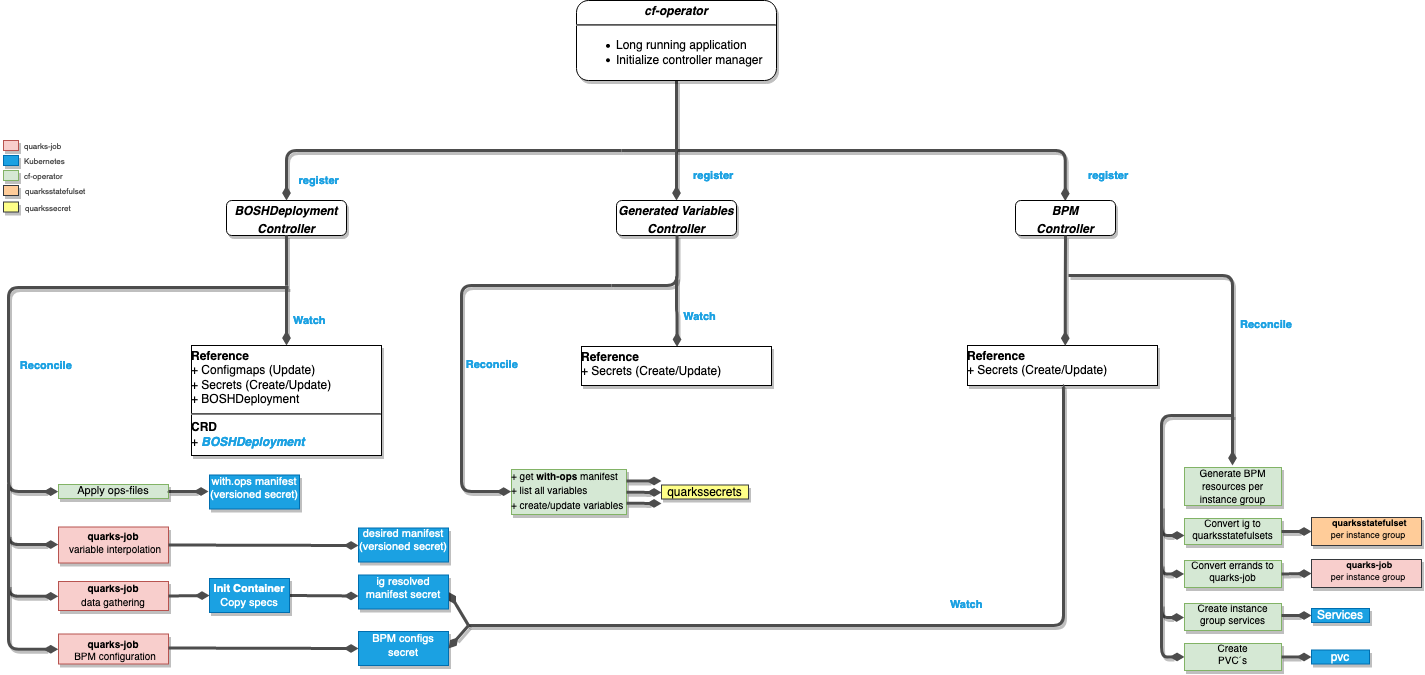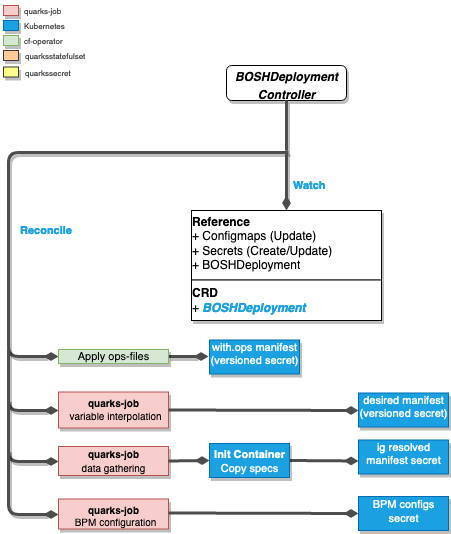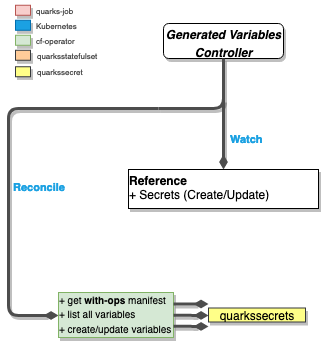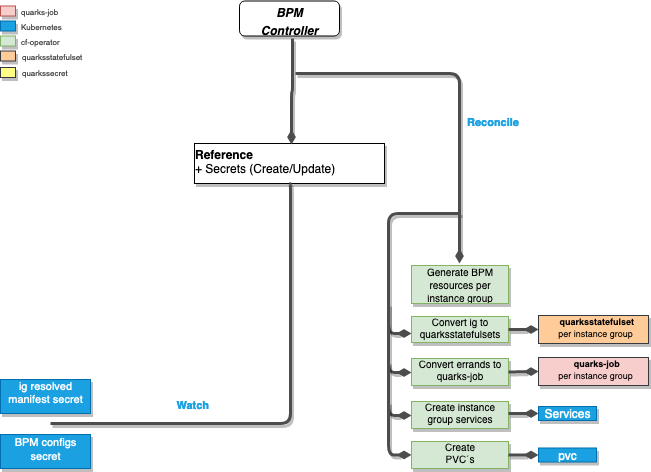BOSH Deployment
Description
A BOSH deployment is created from a deployment manifest and optionally ops files.
The deployment manifest is based on a vanilla BOSH deployment manifest. The ops files modify the deployment manifest. For example, ops files can be used to replace release tarballs with docker images, thus enabling deployment on Kubernetes.
A deployment is represented by the boshdeployments.quarks.cloudfoundry.org (bdpl) custom resource, defined in boshdeployment_crd.yaml.
This bdpl custom resource contains references to config maps or secrets containing the actual manifests content.
The name of the bdpl resource is the deployment name. The name in the BOSH manifest is ignored.
After creating the bdpl resource on Kubernetes, i.e. via kubectl apply, the CF operator will start reconciliation, which will eventually result in the deployment
of the BOSH release on Kubernetes.
BDPL Component
The BOSHDeployment component is a categorization of a set of controllers, under the same group. Inside the BDPL component we have a set of 3 controllers together with one separate reconciliation loop per controller to deal with BOSH deployments(end user input)
Figure 1 is a BDPL component diagram that covers the set of controllers it uses and their relationship with other components(e.g. QuarksJob, QuarksSecret and QuarksStatefulSet)
 Fig. 1: The BOSHDeployment component
Fig. 1: The BOSHDeployment component
Figure 1 illustrates a couple of things. Firstly, at the very top, we have the quarks-operator , which is a long running application with a namespaced scope. When the quarks-operator pod is initialized it will automatically register all controllers with the Kubernetes Controller Manager.
While at a first glance the above diagram looks complex, it can be explained easily by focusing on each controller´s main functions: Reconciliation & Watch.
BOSHDeployment Controller
 Fig. 2: The BOSHDeployment controller
Fig. 2: The BOSHDeployment controller
This is the controller that manages the end user input(a BOSH manifest).
Watches in BDPL controller
BOSHDeployment: CreateConfigMaps: UpdateSecrets: Create and Update
Reconciliation in BDPL controller
- generates
.with-opssecret, that contains the deployment manifest, with all ops files applied - generates
variable interpolationQuarksJob resource - generates
data gatheringQuarksJob resource - generates
BPM configurationQuarksJob resource
Highlights in BDPL controller
Transform the concepts of BOSH into Kubernetes resources:
- BOSH
errandstoQuarksJobCRD instances - BOSH
instance_groupstoQuarksStatefulSetCRD instances - BOSH
variablestoQuarksSecretCRD instance
All of the three created QuarksJob instances will eventually persist their STDOUT into new secrets under the same namespace.
- The output of the
variable interpolationQuarksJob ends up as the.desired-manifest-v1secret, which is a versioned secret. At the same time this secret serves as the input for thedata gatheringQuarksJob. - The output of the
data gatheringQuarksJob, ends up as the.ig-resolved.<instance_group_name>-v1versioned secret. - The output of the
BPM configurationQuarksJob, ends up as thebpm.<instance_group_name>-v1versioned secret.
Generate Variables Controller

Fig. 3: The Generated Variables controller
This is the controller that is responsible for auto-generating certificates, passwords and other secrets declared in the manifest. In other words, it translates all BOSH variables into custom Kubernetes primitive resources. It does this with the help of QuarksSecrets. It watches the .with-ops secret, retrieves the list of BOSH variables and triggers the generation of QuarksSecrets per item in that list.
Watches in GV controller
Secrets: Create and Update.
Reconciliation in GV controller
- generates
QuarksSecretsresources.
Highlights in GV controller
The secrets resources, generated by these QuarksSecrets are referenced by the variable interpolation QuarksJob. When these secrets are created/updated, the variable interpolation QuarksJob is run.
BPM Controller
 Fig. 4: The BPM controller
Fig. 4: The BPM controller
The BPM controller has the responsibility to generate Kubernetes resources per instance_group. It is triggered for each instance_group in the desired manifest, since we generate one BPM Secret for each. The reconciler starts each instance_group as its corresponding secret is created. It does not wait for all secrets to be ready.
Watches in BPM controller
versioned secrets: Create and Update.
Reconciliation in BPM controller
- Render BPM resources per
instance_group - Convert
instance_groupsof the typeservicestoQuarksStafulSetresources. - Convert
instance_groupsof the typeerrandtoQuarksJobresources. - Generates Kubernetes services that will expose ports for the
instance_groups - Generate require PVC´s.
Highlights in BPM controller
The Secrets watched by the BPM Reconciler are Versioned Secrets.
Resources are applied using an upsert technique implementation.
Any resources that are no longer required are deleted.
As the BOSHDeployment is deleted, all owned resources are automatically deleted in a cascading fashion.
Persistent volumes are left behind.
BDPL Abstract view
Figure 5 is a diagram that explains the whole BOSHDeployment component controllers flow, in a more high level perspective.
edit
Fig. 5: The BOSHDeployment component controllers interactions
BOSHDeployment status
The BOSHDeployment status is resolved by a separate controller which tracks the status of QuarksJob and QuarksStatefulSet associated with a deployment.
The controller annotates the instance groups and the jobs counters and it resolves the BDPL State (Deployed, Converting , Resolving) by looking at the associated resources states and computing the overall state.
The BOSHDeployment status spec is composed of the following fields:
|
|
The BOSHDeployment States can be:
- Created
- Converting to Kubernetes Resources
- Resolving Manifest
- Deployed
where “Deployed” is the final state. Note that during deployments, the lifecycle might vary if the same resources are updated subsequently: the status of a BOSHDeployment may go back from Deployed to Converting and Resolving again if updates to the manifest are triggered.
The Reconcile resolves to the Deployed state by looking at the overall counts of QuarksJobs and QuarksStatefulSet associated to the BOSHDeployment and its state:
Converting: AllQuarksJobsbelonging to aBOSHDeploymentare completed, butQuarksStatefulSetaren’t ready yet ( or either way around )Resolving:QuarksJobsbelonging to aBOSHDeploymentaren’t completed,QuarksStatefulSetaren’t ready yetDeployed: AllQuarksJobsandQuarksStatefulSetare ready/completed.
Examples
See https://github.com/cloudfoundry-incubator/quarks-operator/tree/master/docs/examples/bosh-deployment